Budapest is not the only city that has its Freedom Square. In fact, there are several in the region. And these distinguished squares are all problematic in their own particular ways. As part of the EAM project, Vanda Sárai visited the Freedom Squares of Brno, Bratislava and Budapest, to see the monuments in each.
The questions of collective memory have been matters of confrontation in Hungary’s everyday politics for many years now. Monuments have been erected amid heated disputes, political parties often expressed their disapproval of various memorial years held or not held, as well as of the establishment or absence of institutions dedicated to the research and memory of certain historical traumas. Walking in the streets of Budapest, one comes across monuments on almost every corner, but these monuments have never been so invisible and meaningless for the people in the street as they are nowadays.
Even if we often walk past monuments without noticing them at all, it still matters what and how the political players present in them in the public space. This is especially true of monuments in places of historical importance and in busy streets or squares. A battle field of the politics of memory for years now, Budapest’s Szabadság tér (Freedom Square) is a representative example of monuments causing political conflicts as well as of the number of monuments per square metres. The stories and interrelations of the statues erected here clearly demonstrate the divisions in Hungarian society, and the tensions rooted in the past.
A committed and close follower of the events and processes taking place in Szabadság tér, I found it especially exciting to see that the histories of the Szabadság térs (Freedom Squares) in the hearts of Bratislava and Brno are not free of disputes and tensions either. However, these squares reveal trends in the memory of politics in sharply different ways. Therefore, I find it important to compare the role these cities of shared historical roots attribute to their Freedom Squares in their respective urban contexts, and what that tells us about their collective national memories and their use of public space. Furthermore, I consider it significant to explore and show what kinds of (artistic) positions have been expressed in these spaces in response to the official line of the memory of politics, or in an attempt to induce action in this context.
Read EAST ART MAGS on erstestiftung.org magazine
EAST ART MAGS is a project of four art magazines in the East Central European region: Artalk (CZ/SK), Artportal (HU), Revista Arta Online (RO) and SZUM (PL).
EAM is a content making and publishing platform with the aim of capacity building in art journalism in the region, supported by VISEGRAD FUND and AFCN. erstestiftung.org magazine shares selected articles from EAM and translates them into German and – if not yet available – English.
This article by Vanda Sárai was written as part of the EAM’s residency programme and was made possible with the support of AFCN and ICR Budapest. It was first published 19 January 2018 on Artalk (CZ/SK) and on artportal.hu in English and Hungarian.
Then and now
The Freedom Squares of the region have been changed many times during their history, and have fulfilled various functions in the lives of the cities’ inhabitants. Now packed with a wide variety of mionuments, the square in Budapest, was filled with statues expressing disapproval and resentment over the unfairness of the Treaty of Trianon, and demanding its revision. When constructed, the square in Bratislava served as a space for public festivities: then between the two world wars, for military demonstrations, and before the fall of the communist system in 1989, it was called Klement Gottwald Square, in memory of the president of Czechoslovakia – many locals still call it “Gottko” today, while its official name is Námestie Slobody. A market place in the Middle Ages, the square in the centre of Brno got the name that is still used today in 1918, and it was changed temporarily only twice in the past 100 years. In 1939, it came to be called Adolf Hitler Square for a day, and after the German invasion, between 1942 and 1945, its name was changed to Viktoria-Platz, celebrating the German victory over Europe.
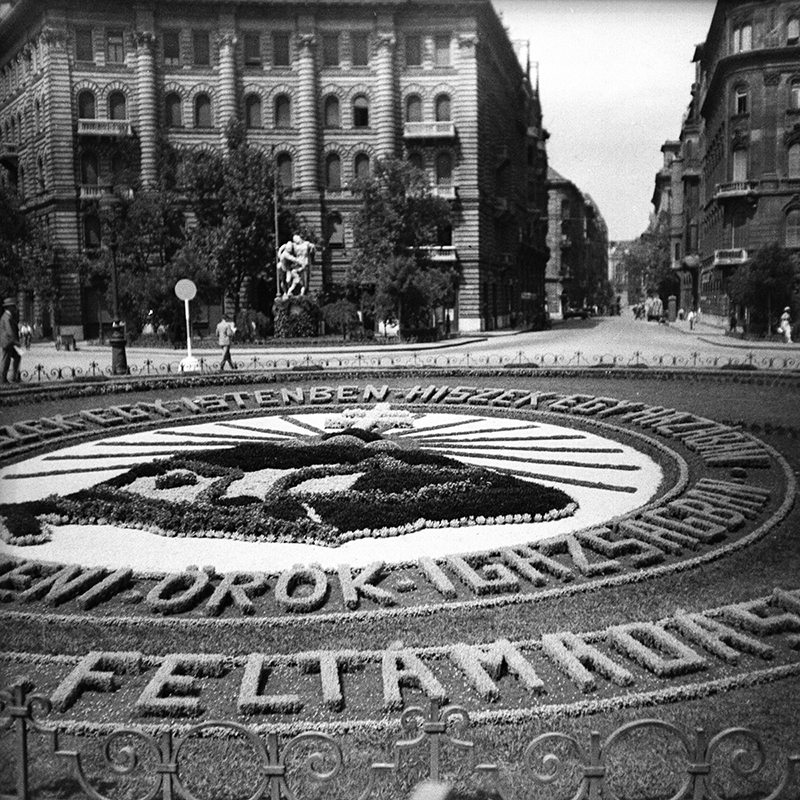
“Irredenta” memory point in the 1930s, Budapest. Photo: Fortepan Archive
While almost nothing has remained of all the revisionist statues erected between the two world wars Budapest’s Freedom Square is packed with monuments. In Bratislava, the Fountain of Union, built on the gigantic square in 1979, has been out of order for ten years – a sad and desolate concrete structure in the city centre. It is constantly on the city’s agenda to do something about the square, but no actual steps have been taken so far. Of the three, Brno’s Freedom Square is the least burdened with politics. Considered a location of special importance, today it is basically a major city transport hub. At the same time, here too, there is a monument that caused public uproar, and no consensus has been reached about it ever since it was erected. At first sight, the three squares may seem to be related by no more than their names. However upon closer scrutiny, they reveal quite similar phenomena – manifested in different forms.
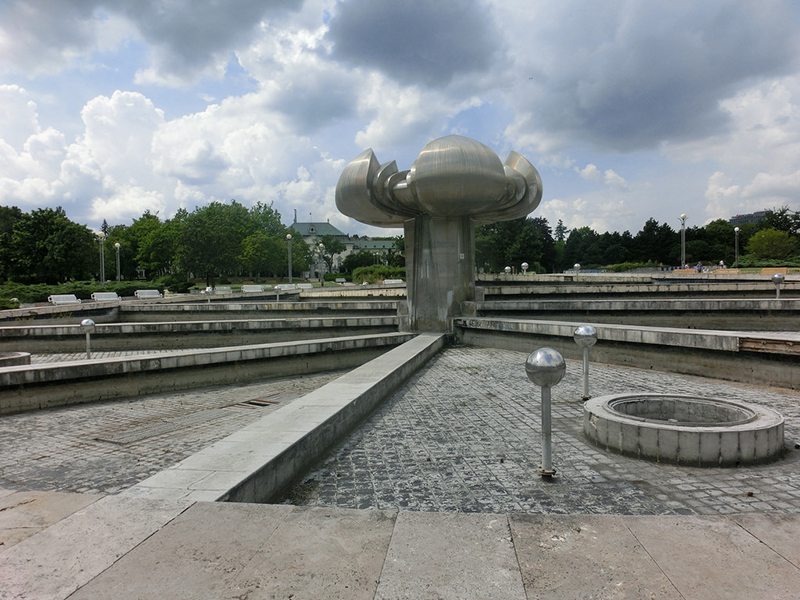
Fountain of Union, Bratislava, Slovakia. Photo: Flickr/ Steve Kirkby
Budapest – the square of monuments protected with fences
Widely covered in local and international media, the story of Budapest’s Szabadság tér is perhaps the best known of the three. Never inaugurated, yet never removed, the monument of German occupation and the scandal it caused dominate the discourse about the square. Meanwhile, it is important to see that the question of Szabadság tér is much more complex than that.
Located in the heart of the city’s 5th district, not far from the Parliament, it is surrounded by buildings like the headquarters of the Hungarian National Bank, the inaccessible building of the US Embassy, and what was once the Stock Exchange Palace, that later became the main site of the Hungarian Public Service Television and is now vacant, waiting to be renovated. Called Szabadság tér since 1900, the square has always been a significant locus of representation, filled with ideologically appropriate statues by each successive regime. After the First World War, the theme of pain over the lost Hungarian territories ruled the square, with The Sculpture of Hungarian Pain donated by Lord Rothermere (click here for details in Hungarian), the National Flag with Relic and the Trianon flower bed. Of the statues erected between the world wars, only the monument of General Bandholtz is still there, with the new inscription on the back that reads: “General Harry Hill Bandholtz, head of the American Military Mission, who on 5 October 1919 blocked the removal of the treasures of the National Museum to Romania.”
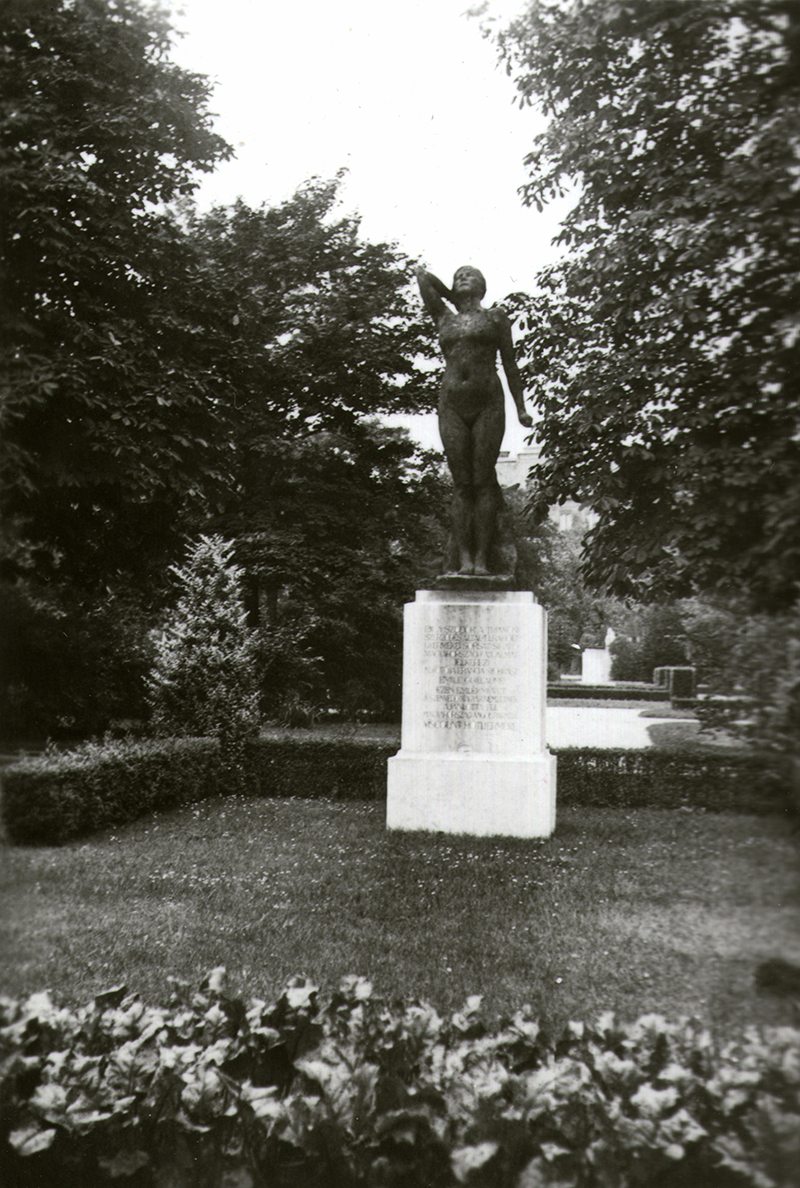
The Sculpture of Hungarian Pain, Emile Guillaume, 1932. Photo: Fortepan Archive
Less known is the fact that the entrance of the Calvinist church called the Church of Returning Home also opens from Szabadság tér. Recently this church has made the news mostly due to the fact that, in 2013, a bust of Miklós Horthy, regent of Hungary between 1920 and 1944 was placed in front of its gate. Although the church is private property, and therefore, erecting the statue there is not considered as an official government act, confrontation between the inaugurators and protesters almost led to a physical clash during the inauguration ceremony. The bust was eventually inaugurated nevertheless.
After World War II, Soviet influence determined the memory of this public square. The memorial monument to Soviet heroes was raised there in 1945 – a theme over which the public is still divided today. A copy of the sculpture made for Stalin’s 70th birthday also stood on the square between 1950 and 1956. The statue titled “To the great Stalin from the Grateful Hungarian People” was blown up during the 1956 Revolution. Acts of protest have repeatedly been launched against the Soviet heroes’ monument, still standing today: it was damaged several times after the change of the political systems, most seriously during the demonstrations against the Socialist government in 2006. Despite the fence around it, graffiti was written on it, and protesters held marches demanding that it be removed from the square. While the fences were eventually removed, the legitimacy of the monument is still a subject of political dispute today.
The Sculpture of Hungarian Pain, Emile Guillaume, 1932. Photo: Fortepan Archive
After the change of the political systems, the square became more eclectic: in 1991, the statue of István Széchenyi was erected; one for Swedish diplomat Carl Lutz was raised in 2006, and an interactive fountain was built on one of its sides in 2010. Ronald Reagan’s statue was inaugurated near the US Embassy in 2011.
These artefacts accompany the infamous German occupation monument, placed there in 2014 – as a kind of antithesis to the Soviet monument. The new monument can serve as the perfect illustration of stalemate situations. Due to fervent protests, it has never been inaugurated officially, while its removal is also out of the question as it would be an open admission of the current government’s mistake and defeat. Communities of artists and historians have raised a wide array of criticisms against the statue sculpted by Péter Párkányi Raab – its anachronistic style being perhaps the least cutting of all. The monument implies much more significant and graver structural problems: it claims that Hungary was a victim in World War II, and all the war crimes as well as collaboration with the Nazis are to be put down to the German occupation. (Click here and here for more on the subject.)
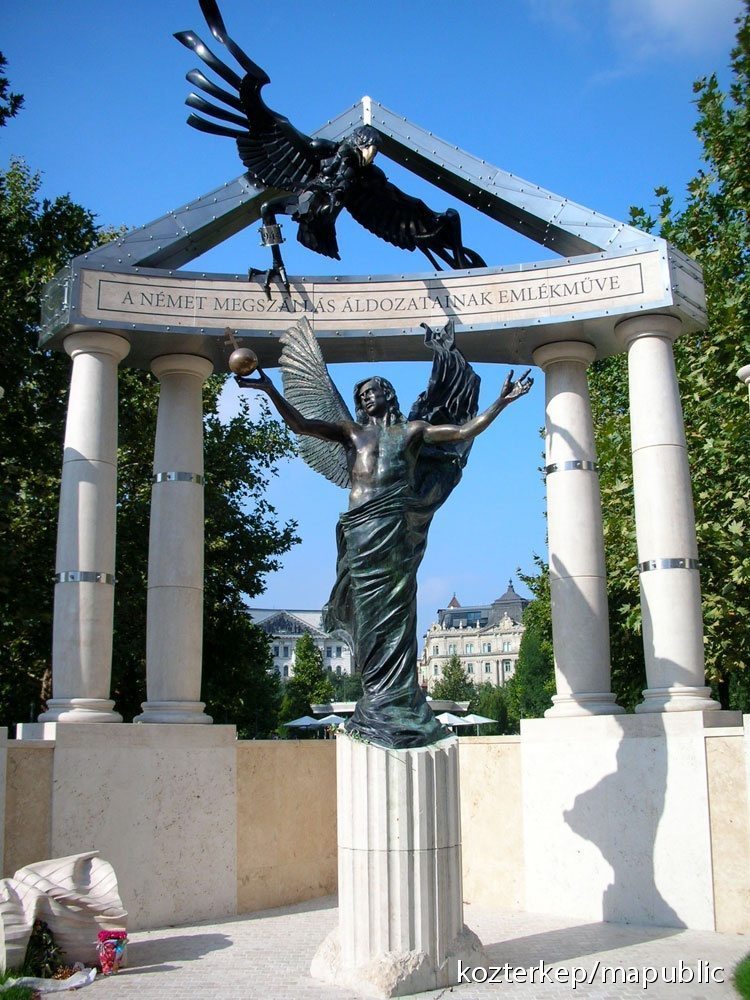
Péter Párkányi Raab: Memorial for the victims of the German occupation, Budapest, 2014. Photo: kozterkep.hu
The removal of the fences around the Soviet monument sparked heavy protest, and so did the inauguration of the bust of Horthy. However, a major protest movement, initiated by the art scene, emerged only in response to the German occupation monument. Proclaiming the importance of continuous discourse and personal memory, in opposition to the official lines of discourse and memory, the groups called Eleven Emlékmű (Living Memorial) and Szabadság Színpad (Freedom Stage), for example, have been protesting persistently, on a daily basis for years now against the monument simplifying historical events. These groups have created their own infrastructures of action. Initiated by artists, historians and art historians (including Péter Béndek, Mária Heller, Balázs Horváth (Byron), György Jovánovics, Noémi Kertész, Balázs Kicsiny, Szabolcs KissPál, András Lukács, Csaba Nemes, András Rényi and others), the action consists of two parts. One is objects of personal remembrance, placed opposite the memorial by people whose family members were killed in World War II, in the Holocaust or on the battle field.
The other part is the discussions regularly organised by the members of Living Memorial – by now, not only about the memorial but about various other events of public life too. Therefore, its significance exceeds that of calling attention to the problem of the German occupation memorial.
Péter Párkányi Raab: Memorial for the victims of the German occupation, Budapest, 2014. Photo: kozterkep.hu
It does the job of clarification that has taken place in the scholarly study of history but not in public consciousness. It points out that, instead of erecting statues, it would make more sense to look at history critically, as a subject of continuous discourse and reinterpretation.
As is shown by the examples above, there has always been an ambition to represent almost all the important (and sometimes less important) themes and moments of our historical memory in Szabadság tér. And when it comes to the representation of controversial issues there, tempers always fly. The disputes that have arisen about the most recent monuments demonstrate clearly how contemporary memory appears in public discourse today, and they also show the stalemate situation and how nothing has a consequence or effect: despite all the protests, both the German occupation memorial that has never been inaugurated, the Soviet heroes’ memorial and the bust of Miklós Horthy have remained there, showing how, instead of attempting to reach a consensus, we are utterly unable to face our 20th century history. The scandals around its monuments surrounded with fences have become part of the square’s identity, which also demonstrates the fact that the current “official” discourse of history is far from unshakeable.
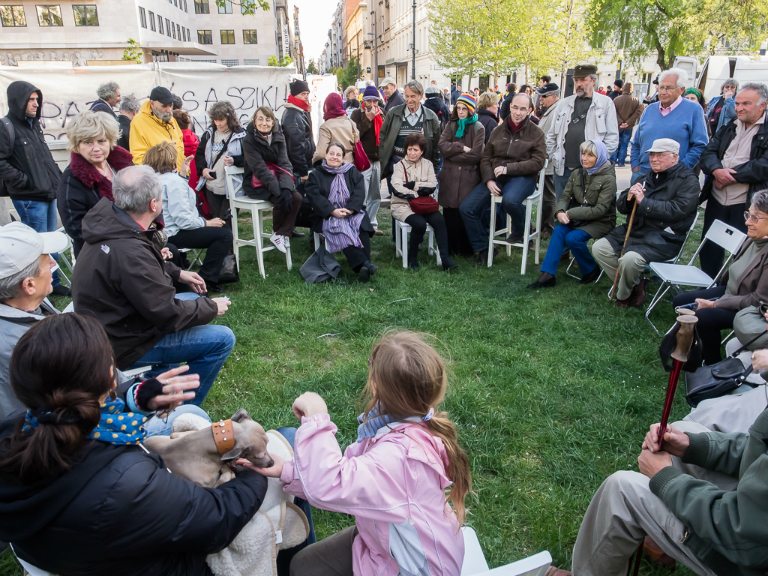
Public discussion in the framework of Living Memorial project. Photo: Living Memorial Group
Bratislava – the square where time has stopped
I had walked past Bratislava’s Námestie Slobody many times before I realized what its name means, and also the fact that it shares not only its name but also its position with its namesake in Budapest. Called Klement Gottwald (Gottko) Square before the change of the political systems, it was already an important space of representation: the Czechoslovak prime minister’s statue was erected here in 1980, and the square became a venue of political rites, commemorating among other things the anniversaries of Gottwald’s birth or of the Communist takeover. The statue was finally demolished in 1991, with only its pedestal remaining to tell the story today.
The historically reputable square has become the sad legacy of the communist era. Covered with concrete, it is totally desolate. Its only prominent feature, the Fontána Družby (Fountain of Friendship), built in 1979, has been out of service for about ten years now – only local skateboarders and bikers use it for practicing stunts. Of course, urban planners are well aware of the issue, and finding an alternative solution repeatedly appears on their agenda. One of these was to move here the statue of the activist and language reformer Ľudovít Štúr, and another idea was to build a memorial monument to the Velvet Revolution, which started on 17 November 1989. However, as opposed to the fast pace of erecting monuments in Budapest, none of the plans has been carried out in Bratislava.
In the same way that the German occupation monument sparked heavy protest in Budapest, the shameful abandonment of Námestie Slobody triggered a response on the part of the Slovak art scene. However, while in Hungary the artists had to oppose an active political line of action, in Slovakia they had to take action and offer an alternative to passivity and procrastination.
One of the best known examples of the projects aimed at the rehabilitation of Námestie Slobody was Project Point 0, initiated in 2011 by the Public Pedestal (initiators: Dalibor Bača, Martin Piaček, Tomáš Džadoň, Michal Moravčík). The participants’ declared aim was to “proactively revitalise the layers of history underlying the place.” They started by inviting an artist from each Visegrad country to make ephemeral projects that reflect on the history and significance of the space by way of creating a free artistic space.
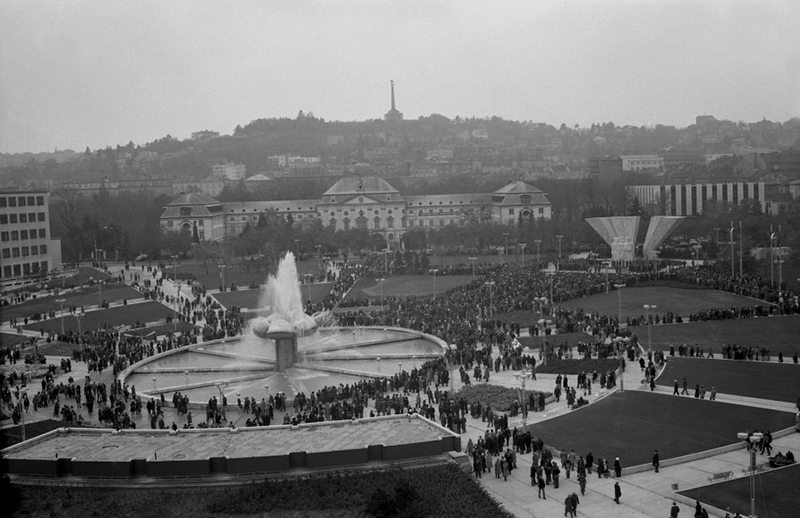
Námestie Slobody, Fontána Družby. Photo: Bratislava.dnes24.sk
Building a playground on the square, Polish artist Pawel Althamer’s project was aimed at creating a space where he could invite kindergarten kids and primary school pupils to respond to the square spontaneously. Children often play a key role in Althamer’s work. Here, he turned the non-functional fountain into a sandbox. His aim was for children to meet in the sandbox and while playing together to make the rules of the square. The adults’ role was only to provide the framework (the sandbox), and Althamer gave full freedom to the children in using their creativity. The action was planned for one day, and he says it may be useful to repeat the event sometimes, on special occasions.
Szabolcs KissPál, the Hungarian participant reflected on history more directly. In his intervention called Coronation Valley, he conjured up the role of the coronation hill and Bratislava as the coronation city, which it once had been. He planned to dig a semi-spherical hole in the square, and to place the earth dug out in museums across the seventy counties of the former Austro-Hungarian Monarchy, and to leave the project’s description beside the hole. While temporary in its essence, his action would also have generated a kind of permanence through being represented in the museums.
Representing Slovakia, Ilona Németh’s installation titled Sahara was intended to stir (literally) the various layers of the square’s history and present. Using smoke grenades, torches and mist, she planned to make a tornado-like object, which would occur from time to time, and building through destruction, would point out the inevitability of historical changes and continuous transition. With her event-type performance, Németh also reflects on the fact that it is perhaps not the best strategy to erect a memorial monument to an unpredictable future.
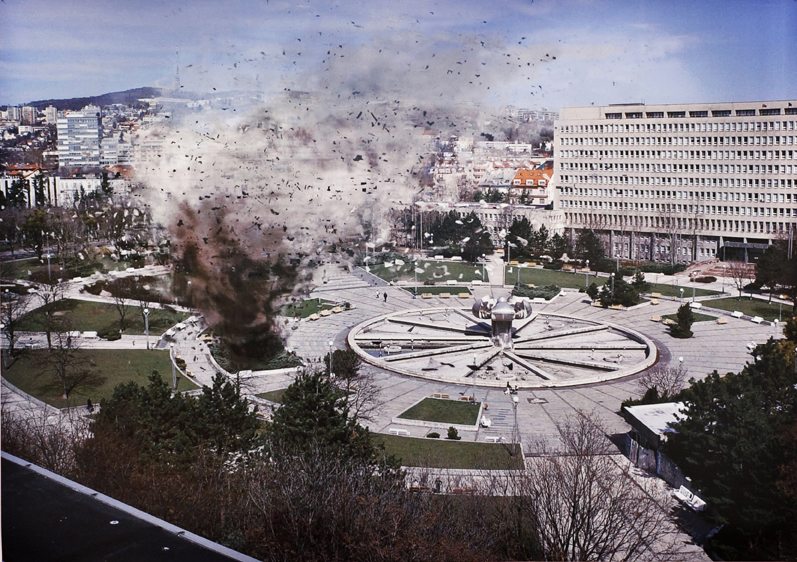
Ilona Németh: Sahara. Photo: http://www.verejnypodstavec.com/bod_0_en.html
Last but not least, Krištof Kintera, the project’s Czech participant, aimed to explore questions of using public space. His work titled 1€ PUBLIC JUKE BOX was exactly what its name said: a juke-box on a pedestal, which could be used by anyone by inserting a one-euro coin, and the sound from the machine could then be heard all over the square. However, instead of the usual music played in pubs, this juke box offered a much more eclectic choice: a mix of Václav Havel’s speeches, Strauss’s Radetzky March, dog barking, whale whistles, Beethoven, the Sex Pistols and others. The extent to which it is possible for someone to play their favourites echoing in the public space for one euro is amply shown by the number of complaints people living or working around the square made to the police…
Parts of the Project Point 0 in 2011, these projects proposed ways to use Námestie Slobody. As nothing changed over time, several other artistic actions have taken place there since then: Based on the Public Pedestal, Magdalena Kuchtova made a performance there in 2014, and in 2016, Jonáš Gruska used the fountain for a site-specific sound installation in the Nomadic Arts Festival.
Unfortunately, nothing seems to have changed so far. Now, in the autumn of 2017, the place can still be called “the square where time has stopped”. Námestie Slobody is the total opposite of its counterpart in Budapest: while Szabadság tér has become a space in ever-ongoing games of the politics of memory, Námestie Slobody is the frozen memory of the communist era, waiting for urban planners to reanimate it and bring it to a better and more fitting life.
Brno – the dilemma of the phallic clock
Compared to its namesakes in Budapest and Bratislava, Brno’s Náměstí Svobody may not seem very special. While a place of special importance in the city’s life, and also the location of a controversial monument, its function is totally different from that of the other two squares.
One of Brno’s centres, Náměstí Svobody presents a totally different view of history with its monuments, compared to those manifest in the capitals of Slovakia and Hungary. Formerly a marketplace, today the square is a transport hub and a site of various fairs. At present, there are four monuments there: a column erected in 1689 as a reminder of the outbreak of the plague; a bronze fountain ornamented with a few lines by local poet Jan Skácel; the discreet outlines of the foundations of the demolished Church of St Nicholas on the pavement; and last but not least, an astronomical clock made of black granite. Installed in 2010, this monument has been sparking disputes ever since.
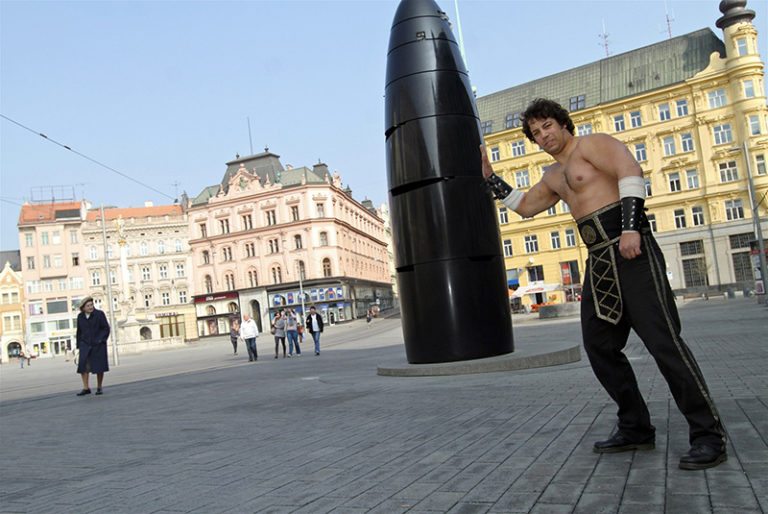
Freedom Square, Brno. Photo: Jiří Salik Sláma, MAFRA Forrás: Brno.idnes.cz
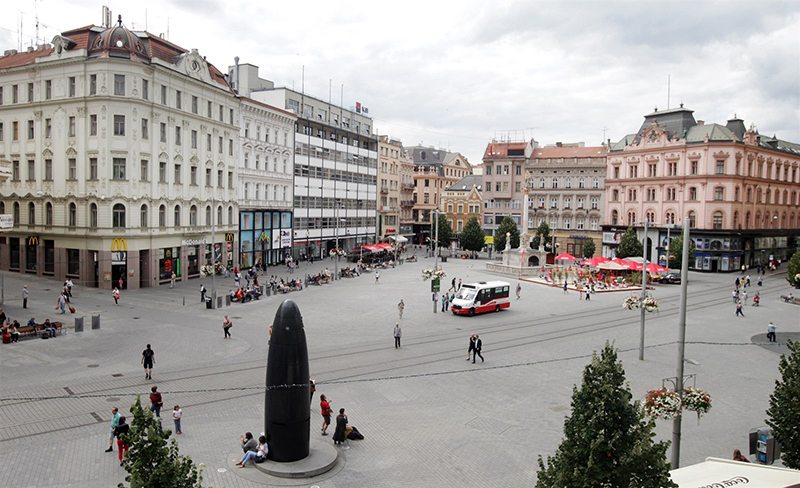
Freedom Square, Brno. Photo: Jiří Salik Sláma, MAFRA Forrás: Brno.idnes.cz
Szabadság tér ≠ Námestie Slobody ≠ Náměstí Svobody (?)
Taking a close look at the three cities’ three Freedom Squares, it has become clear that all three are significant not only because of their geographical location but also in terms of their role in historical representation. Furthermore, quite clearly, the three cities adopt sharply different approaches to their history, and they also differ in their views about what role a square with the word freedom in its name has to play in shaping that view.
It seems now that in Budapest monuments will continue to be erected in the square until the last square inch is filled up, in order to ensure the survival and dominance of the current narrative about Hungary being a victim. By contrast, Bratislava seems to have forgotten about the issue a little bit: freezing an important moment of the communist past, it seems to be waiting for the right moment to move on. Far from the other two, Brno looks back much further in its history, not concerning itself with the disputes and controversies of its more recent past.
Special thanks: Martin Piacek, Eliska Mazalanová
Original version in Hungarian. Translation by Zsolt Kozma.
This text is protected by copyright: © EAM. If you are interested in republication, please contact the editorial team. Cover picture: Freedom Square, Budapest. 2013. Photo: FreeDoc / Gabriella Csoszó